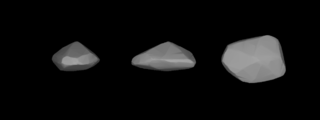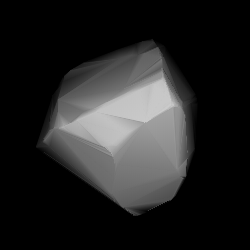
391 Ingeborg is an asteroid and second-largest Mars-crosser on an eccentric orbit from the asteroid belt. It was discovered by German astronomer Max Wolf on 1 November 1894, at the Heidelberg Observatory in southwest Germany. When discovered, it was observed for a couple of weeks, and follow-up observations were made in 1901 and 1904.
468 Lina, provisional designation 1901 FZ, is a dark Themistian asteroid from the outer region of the asteroid belt, approximately 60 kilometers in diameter. It was discovered on 18 January 1901, by German astronomer Max Wolf at the Heidelberg Observatory in southwest Germany. The carbonaceous asteroid was named for the housemaid of the discoverer's family.

512 Taurinensis, provisional designation 1903 LV, is a stony asteroid and large Mars-crosser on an eccentric orbit from the inner regions of the asteroid belt, approximately 20 kilometers in diameter. It was discovered on 23 June 1903, by astronomer Max Wolf at the Heidelberg-Königstuhl State Observatory in southwest Germany. The asteroid was named after the Italian city of Turin. It is the 4th-largest Mars-crossing asteroid.
Lilofee, provisional designation 1923 OK, is a carbonaceous Themistian asteroid from the outer regions of the asteroid belt, approximately 33 kilometers in diameter. It was discovered on 13 September 1923, by astronomer Karl Reinmuth at the Heidelberg-Königstuhl State Observatory in southwest Germany. The asteroid was named after the Black Forest mermaid "Lilofee" from German folklore.

1021 Flammario, provisional designation 1924 RG, is a dark background asteroid from the central regions of the asteroid belt, approximately 100 kilometers in diameter. It was discovered on 11 March 1924, by German astronomer Max Wolf at the Heidelberg-Königstuhl State Observatory in Heidelberg, Germany. The asteroid was named after French astronomer Camille Flammarion. The uncommon F-type asteroid has a rotation period of 12.16 hours.
3204 Lindgren, provisional designation 1978 RH, is a carbonaceous background asteroid from the outer regions of the asteroid belt, approximately 20 kilometers in diameter. It was discovered on 1 September 1978, by Soviet astronomer Nikolai Chernykh at the Crimean Astrophysical Observatory in Nauchnij, on the Crimean peninsula. The B-type asteroid has a rotation period of 5.6 hours. It was named after Swedish writer Astrid Lindgren.
1154 Astronomia, provisional designation 1927 CB, is a carbonaceous background asteroid from the outer regions of the asteroid belt, approximately 60 kilometers in diameter. It was discovered by German astronomer Karl Reinmuth at the Heidelberg-Königstuhl State Observatory on 8 February 1927. The asteroid was named for the natural science of astronomy.
1213 Algeria is a carbonaceous asteroid from the outer region of the asteroid belt, approximately 32 kilometers in diameter. Discovered by Guy Reiss at Algiers Observatory in 1931, it was named after the North African country of Algeria.
3581 Alvarez, provisional designation 1985 HC, is a carbonaceous asteroid and a very large Mars-crosser on an eccentric orbit from the asteroid belt, approximately 13.7 kilometers in diameter. It was discovered on 23 April 1985, by American astronomer couple Carolyn and Eugene Shoemaker at the Palomar Observatory in California. The likely spherical B-type asteroid has a rotation period of 33.4 hours. It was named for scientists Luis Alvarez and his son Walter Alvarez.
1474 Beira, provisional designation 1935 QY, is a bright carbonaceous asteroid and large Mars-crosser on an eccentric orbit from the asteroid belt, approximately 15 kilometers in diameter. It was discovered on 20 August 1935, by South African astronomer Cyril Jackson at the Union Observatory in Johannesburg. The asteroid was named after the port city of Beira in Mozambique.

1576 Fabiola, provisional designation 1948 SA, is a Themistian asteroid from the outer regions of the asteroid belt, approximately 27 kilometers in diameter. It was discovered on 30 September 1948, by Belgian astronomer Sylvain Arend at the Royal Observatory of Belgium in Uccle. The asteroid was named after Queen Fabiola of Belgium.

1444 Pannonia is a carbonaceous background asteroid from the outer region of the asteroid belt, approximately 29 kilometers in diameter. It was discovered on 6 January 1938, by Hungarian astronomer György Kulin at Konkoly Observatory in Budapest, Hungary. It was named after the ancient province of the Roman Empire, Pannonia.

1484 Postrema, provisional designation 1938 HC, is a carbonaceous Postremian asteroid and namesake of the Postrema family from the central regions of the asteroid belt, approximately 41 kilometers in diameter. It was discovered on 29 April 1938, by Soviet astronomer Grigory Neujmin at the Simeiz Observatory on the Crimean peninsula. The name "Postrema" celebrates the astronomer's last minor planet discovery.

1204 Renzia is a stony asteroid and sizable Mars-crosser on an eccentric orbit from the inner regions of the asteroid belt, approximately 10 kilometers in diameter. It was discovered by astronomer Karl Reinmuth at the Heidelberg-Königstuhl State Observatory in southwest Germany on 6 October 1931. The asteroid was named after German-Russian astronomer Franz Renz.
2629 Rudra, provisional designation 1980 RB1, is a sizable Mars-crossing asteroid and slow rotator inside the asteroid belt, approximately 5.3 kilometers (3.3 miles) in diameter. It was discovered on 13 September 1980, by American astronomer Charles Kowal at the Palomar Observatory in California. The dark B-type asteroid has a long rotation period 123 hours and likely an elongated shape. It was named after Rudra from Hindu mythology.

1493 Sigrid, provisional designation 1938 QB, is a dark Nysian asteroid from the inner regions of the asteroid belt, approximately 24 kilometers in diameter. It was discovered on 26 August 1938, by Belgian astronomer Eugène Delporte at the Royal Observatory of Belgium in Uccle. It was named after Sigrid Strömgren, wife of astronomer Bengt Strömgren.
1340 Yvette, provisional designation 1934 YA, is a carbonaceous Themistian asteroid from the outer regions of the asteroid belt, approximately 29 kilometers in diameter. It was discovered on 27 December 1934, by astronomer Louis Boyer at the Algiers Observatory, who named it after his niece, Yvette.

1310 Villigera, provisional designation 1932 DB, is a stony asteroid and large Mars-crosser from the innermost regions of the asteroid belt, approximately 14 kilometers in diameter. It was discovered on 28 February 1932, by German astronomer Friedrich Schwassmann at Bergedorf Observatory in Hamburg, Germany. The asteroid was named after astronomer Walther Villiger.
988 Appella, provisional designation 1922 MT, is a dark Themistian asteroid and slow rotator from the outer region of the asteroid belt, approximately 26 kilometers in diameter. It was discovered on 10 November 1922, by Russian–French astronomer Benjamin Jekhowsky at Algiers Observatory in Algeria, North Africa. The asteroid was later named after French mathematician Paul Émile Appel.

7517 Alisondoane is a dark background asteroid from the inner regions of the asteroid belt. It was discovered on 3 January 1989, by Japanese amateur astronomer Takuo Kojima at the YGCO Chiyoda Station in the northern Kantō region of Japan. The carbonaceous C-type asteroid has a rotation period of 9.7 hours and measures approximately 9 kilometers in diameter. It was named after Alison Doane (1958–2017), curator of astronomical photographs at the Harvard College Observatory.










